Stay One Step Ahead with the Best Payment Methods for Online Casino Bonuses
When it comes to online gambling, finding the best MuchBetter casino sites can make all the difference in your gaming experience. MuchBetter is an innovative payment solution that allows players to make fast and secure transactions. With its seamless integration and user-friendly interface, this e-wallet has gained popularity among online casino enthusiasts. Whether you are a seasoned player or new to online gambling, choosing a MuchBetter casino can provide you with a convenient and enjoyable gaming experience.
One of the top MuchBetter casino sites is https://csiss.org/deposit-methods/muchbetter/. This online casino has embraced MuchBetter as a preferred payment method, ensuring that players can easily deposit and withdraw funds. CSISS offers a wide selection of casino games, including slots, table games, and live dealer options. With its user-friendly website and mobile app, players can enjoy their favorite casino games on the go. The casino also boasts a generous welcome bonus and regular promotions, ensuring that players have ample opportunities to boost their bankroll.
Another excellent MuchBetter casino option is csiss. Known for its extensive game selection, this online casino caters to players of all preferences. From classic slots to progressive jackpots and live casino games, there is something for everyone at CSISS. The site also features a sleek and modern design that allows for easy navigation, making it a pleasure to explore the wide range of games. With its integration of MuchBetter as a payment option, players can enjoy swift and secure transactions, ensuring that their gaming experience is hassle-free.
In conclusion, selecting the best MuchBetter casino sites can greatly enhance your online gambling experience. Not only does MuchBetter provide a convenient and secure payment solution, but it also allows for seamless integration with top online casinos like csiss.org. With its extensive game selection, user-friendly interface, and generous promotions, [CSISS] is an excellent choice for players looking for a top-notch gaming experience. So, why not give MuchBetter a try and enjoy the benefits it brings to your casino gaming?
When it comes to online gambling in Austria, one of the most important factors to consider is the withdrawal process. Players want to ensure that they can access their winnings quickly and conveniently. That`s why the best online casino instant withdrawal in Austria is in high demand among avid gamblers. One platform that stands out in this regard is https://online-casino-osterreich.org/sofort/. With its seamless and efficient withdrawal system, players can enjoy their winnings instantly.
One of the key reasons why this online casino is considered the best for instant withdrawals is its partnership with reputable payment providers. They offer a wide range of options, including popular e-wallets such as Skrill and Neteller, as well as traditional bank transfers. This means that players can choose the method that suits them best and receive their funds without any unnecessary delays. Additionally, the casino`s user-friendly interface and intuitive navigation contribute to a smooth withdrawal process.
Moreover, this platform also prioritizes security and fairness. It holds a valid gambling license, ensuring that players` transactions and personal information are protected. Furthermore, it provides a wide selection of high-quality games from renowned software providers, guaranteeing a fair gaming experience. Whether you prefer slots, table games, or live dealer options, this online casino has something to cater to every player`s taste.
In conclusion, if you`re looking for the best online casino with instant withdrawal options in Austria, online-casino-osterreichis the ideal choice. Its partnership with reputable payment providers, commitment to security and fairness, and extensive game selection make it a top-notch platform for any passionate gambler. Experience a seamless and convenient withdrawal process today by visiting their website.
When it comes to online casinos, one of the most important aspects for players is the availability of secure and convenient payment methods. This is where ecoPayz casinos online truly shine. As one of the best providers in the industry, ecoPayz ensures that players can enjoy a seamless and hassle-free gaming experience while keeping their financial information safe. With its user-friendly interface and widespread acceptance, ecoPayz is a preferred choice among online casino enthusiasts.
One of the top ecoPayz casinos online is https://online-casino-schweiz.org/ecopayz/. This casino not only offers a wide range of exciting games and lucrative bonuses but also provides the option to use ecoPayz for deposits and withdrawals. With just a few clicks, players can easily transfer funds, ensuring a smooth and efficient gaming experience. Additionally, this casino prioritizes customer security, utilizing advanced encryption technology to protect sensitive financial details.
Another reputable ecoPayz casino is [Your Anchor Text]. With its sleek and modern design, this casino attracts players from all over the world. Thanks to its collaboration with ecoPayz, players can enjoy quick deposits and withdrawals without any additional fees. Moreover, the casino offers a generous welcome bonus and ongoing promotions to enhance the overall gaming experience. With its extensive collection of games and seamless integration with ecoPayz, this casino is a top choice for online gamblers.
In conclusion, ecoPayz casinos online are excellent options for players looking for a secure and convenient payment method. With widespread acceptance and a commitment to user safety, ecoPayz ensures that players can enjoy their favorite casino games without any worries. By choosing top ecoPayz casinos like [Your Anchor Text], players can enjoy a seamless gaming experience while benefiting from quick and hassle-free financial transactions.
At long last, I reveal my blog’s sleazy ulterior motive: hoodwinking you into buying my crap! Bwa-ha-ha.
I exaggerate. But after several years of scheming, I’ve figured out a way to bring my stompbox designs to market that will permit me to keep doing stuff I love, like writing geeky stuff for my blog and music magazines, recording and gigging, and continuing to create new gizmos.
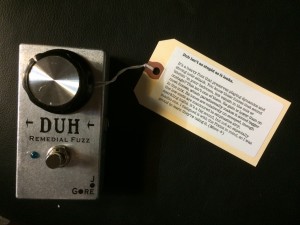 Can you help me figure out this super-complicated pedal? Here’s the deal: I’ve partnered with Vintage King, a leading purveyor of high-end audio gear, to sell my stompbox designs through their online store and their retail shops in LA and Nashville. (They also ship overseas.) They’re being manufactured to my specs by Cusack Music in Michigan. (In addition to their own highly regarded pedal line, Cusack builds for many other boutique brands, often anonymously.) I’m working with a brilliant young engineer named Tony Lott, who not only goes the extra mile to accommodate my weird requests, but routinely offers suggestions that improve my designs.
Here a little promo video for our first release, Duh Remedial Fuzz:
Look and sound familiar? Yeah, I’ve been using the circuit in recordings and demo videos for a couple of years now, either in stompbox form, or built right into guitars. The final, official version of Duh is on the cover of this month’s Guitar Player magazine, and GP’s Mike Molenda wrote a real sweetheart of a review:
Joe Gore treated me to a very early prototype of the Duh a few years ago, and its brilliant design—one knob (for “louder”), whimsical name, responsive dynamics (with both performance gestures and guitar-volume manipulations), and simultaneously fierce and expressive tone—ensured that the battered test version never left my pedalboard. The new, tough and ready for prime time, U.S.-made Duh is similarly remarkable. The additional R&D time has really paid off, as this is a pedal that doesn’t give up one less-than-spectacular sound. It reminds me of ’60s records where the fuzz sounds jumped right out of the grooves and changed my world forever.
Shucks, Mike! Guitar Player even bestowed their coveted Editors Pick award. Equally shucks-inducing is the fact that the Pixies have been using Duh since last year. Be still, my punk-pop heart.
What does it mean for this blog? Probably not much, beyond an occasional new product plug like this one.
I put together a little FAQ about my stompboxes. It’s here if you’re curious. You can order pedals from my Vintage King page. More releases are coming very soon, including improved versions of my Cult, Screech, Boring, Purr, Gross, Filth, Storybook, and Drive Without a Face pedals.
Till then, feel free to curse my sudden but inevitable betrayal. :satansmoking:
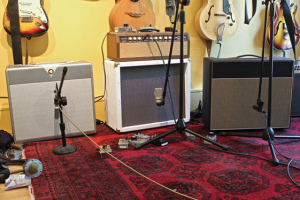 This photo was originally a line of 137 amps, but I had to crop it to fit this small space. Premier Guitar has just posted a new installment in my Recording Guitarist column. The topic: doubling riffs for fatter sounds. Using a single guitar part (and a great drum performance swiped from Dawn Richardson), I tried every doubling trick in the book. plus some ones that wise editors expunged from the book. We’re talking amps, mics, panning, processing, analog vs. digital—real OCD stuff.
Is it interesting enough to justify listening to the same part doubled 20 different ways? Depends how big a geek you are!
For the less geeky, here’s a concise executive summary:
Q. How many doubles do you need for maximum fatness?
A: Between zero and a lot.
Q: How many is too many?
A: Fewer than the 21 tracks in my last over-the-top example.
That, plus some helpful information, just to keep things lively. :smirk:
Few guitar pedals can rival the cult cachet of the Harmonic Percolator, a singularly ugly distortion stompbox produced in minuscule numbers in the early ’70s by Interfax, a small company based in Milwaukee, Wisconsin. And guess what? They sound ugly too, though they’re ugly in a cool and useful way.
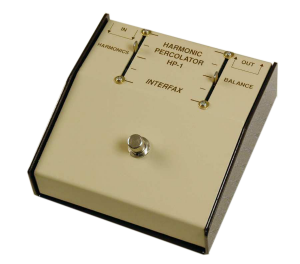 They don’t get much rarer — or uglier. (This is a cosmetically faithful reproduction from Theremaniacs.) I’ve been wanting to write about these for years, but was hindered by the fact that I don’t have access to one. No one does! Well, except the pedal’s best-known user, producer/guitarist Steve Albini. (Steve has posted several popular YouTube videos in which he sings the praises of the original and evaluates it against modern clones.)
But I revisited the idea recently when Christian Magee, who runs Tube Depot, sent me a couple of old 2N404A transistors from a stash he recently acquired. This rare PNP germanium transistor appeared in the original, along with an NPN 2N3565 (also rare, but not as ridiculously rare as the 2N404A). Yes—this pedal uses both a positive-ground germanium transistor and a negative-ground silicon transistor in the same circuit. (Another Fuzz Face/Tone Bender clone, this ain’t!)
I whipped up several variants:
• a clone using the original parts
• a near-clone using more readily available alternatives
• a Harmonic Jerkulator, an all-silicon/no-diodes variation created by DIY stompbox titan Tim Escobedo
• an experimental version with extra controls
Survey the wreckage:
Post-mortem after the jump.
MORE→
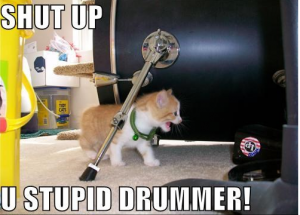
The Cro-Mag Comedy Competition polls have closed. We have a winner and two runners-up tied for second.
The gold medalist is wrangle, for his touching coming-of-age tale about the day he learned there’s a reason musicians say “One two three four” before they start playing. Tied for second: Mark Spangler’s harrowing near-death experience as Jeff Beck’s hand-picked opening act, and Roel Torres’s terrifying tale of being hoisted skyward by stage machinery. (Think twice before wearing a hoodie onstage, kids!) Both are worthy of reenactment on one of my fave guilty-pleasure TV shows, I Shouldn’t Be Alive.
Winners, send me your snail mail addresses, and I’ll send you something noisy.
Thanks to everyone who submitted a story, voted in the poll, or just read the stories and spewed coffee on their computers. Thanks for holding court while I was traveling, and for giving me plenty of good laughs on the road. In the meantime, I’ve pretty much gotten over jetlag, flu, and a mountain of postponed paying work, and I’ve got some cool and intriguing posts planned for the coming days!
You can read all the entires here. Or just the finalists here. Or just the winners after the jump.
MORE→
Part of my recent trip to Europe was a scholar-led tour of Late Paleolithic cave art, starting in the Vézère river valley of France’s Dordogne and working west to northern Spain’s Cantabria region. I’m no expert on the era — just an armchair history geek with a lifelong early art fascination. I could bore you to tears with my holiday pics, but since this is theoretically a guitar/music blog, I’ll keep things brief and music-focused.
 This sculpture of an early hominid from the Museum of Human Evolution in Burgos, Spain, has nothing to do with the fully modern homo sapiens who decorated the caves. Furthermore, recent research calls into question the historical accuracy for her guitar. Some scholars even suspect that it may have been Photoshopped into this photo. Basically, I got to visit many of the best cave art sites not closed to the public, as both Lascaux and Altimira have been for many years. By sheer coincidence, one fellow geek was Hollywood composer Craig Safan, perhaps best known as the composer for Cheers. In addition to being a cool, smart, and fun guy, Craig has been obsessed with these caves since he visited them decades ago as a young man, and is planning a major composition inspired by them. Unlike me, he was up to date on all the latest research about music and musical instruments of the era, mostly based on fragments of simple flutes, bull roarers, and such.
Craig was traveling with a tiny Zoom recorder, a little ocarina, and a pair of small resonant stones. As we’d tour various cave sites as Font de Gaume, Pech Merle, El Castillo, and Isturitz, he discretely record little clacks, whistles, and tongue clicks, cave ambience and all.
Now, the last thing I’d planned for this vacation was an impulse response reverb experiment, especially after having recently written about the technology in this blog and for Premier Guitar. But it occurred to me that we might be able to capture the ambience as impulse responses in order to reproduce it later in the studio. I didn’t have a proper device for playing back a test tone, though I might have tried it on a phone or iPad. But Craig’s clacks and clicks seemed like they might work. He sent me a few audio files after we both got back to California. With a little editing and EQing, they worked pretty well — have a listen below, and help yourself to a couple of reverb files if you like. Some of the nicest are from the deepest gallery of Pech Merle.
MORE→
Hi — I’m back from an amazing vacation, which I’ll tell you about soon. But first, I wanted to make good on my threat/promise of letting you vote on the funniest musician anecdote, a contest outlined here. I couldn’t narrow it down to 10 faves, so I went with 11. (In retrospect, I probably should have skipped the pre-selection stage, since all the stories were pretty darn good.)
Vote for the ones that make you laugh the most. The authors of the three most popular stories win one of my sketchy homemade stompboxes prototypes.
 I apologize. For appropriating this image. For posting it here. For making you dream about it. The only rule: Be cool. Please don’t stuff the ballot box or resort on other sneaky internet tricks. If you win via subterfuge, I’ll still probably send you a prize, though I reserve the right to expose your cheatin’ heart to public ridicule.
Polls close a week from today on Wednesday, May 7th.
The stories appear in random order. The polling widget appears after the last story.
And oh — for the record, don’t take the words “Cro-Mag Comedy Contest” as a slur against our Upper Paleolithic ancestors. Cro-Magnons were fully developed humans, genetically, physically, and mentally indistinguishable from modern homo sapiens. So we can safely assume they did all kinds of stupid shit. Especially the drummers.
MORE→
I was just in Europe, but I’m heading right back — this time on vacation. We’re going to spend a few days knocking around some fave cities, then embark on a tour of Paleolithic cave painting sites in France and Spain.
 Our Cro-Magnon ancestors had to contend with such hardships as poor stage lighting, inadequate sound reinforcement, and excessively reflective surfaces. I know it’s hard to tell when I’m being sarcastic, but this time I’m not. I wanted to be an archaeologist as a kid, until my mom said, “Why? All you’ll do is sit in a closet polishing worthless scraps with a toothbrush.” (Fortunately, she was more supportive of my musical dreams. She never said, “Why do you want to be a studio musician? All you’ll do is sit in a closet polishing worthless scraps with Pro Tools.”)
Since I won’t be able to post and reply as often as usual until I return at the end of the month, I figured you guys could help me keep things interesting. Which brings me to the latest tonefiend contest: the Cro-Mag Comedy Competition!
The rules are simple, just like the musicians we’ll be poking fun at. All you must do to enter is post a funny musical anecdote to the comments section below. It doesn’t have to be about musical stupidity, though experience suggests that those are the funniest stories. Nor does it have to be about guitar, though there are few things stupider than stupid guitarist stories. (Drummer, bassist, and vocalist stories are the obvious exceptions.) The tales should be true, or at least sufficiently true-sounding to dupe the rest of us. If they involve real people, please change their names enough to avoid legal action.
I’ll winnow down the entires to a manageable number via some as-yet-undertermined means (dartboard, or maybe animal entrails), and you, dear readers, will get to select the final three winners, each of whom will receive one of my unique handmade stompboxes, created in a closet at my cutting-edge workbench out of worthless scraps premium mojo parts.
Enter as many times as you like — but please, only one anecdote per comment. Also, please post your anecdotes here on the site, rather than in Facebook comments. Stories can be as long as you like, but remember: Your judges will be musicians, so they may have difficulty grappling with complex sentences.
The contest runs till I get back, or till jet lag subsides — whichever comes last.
Here’s a sample story to get the ball rolling. Naturally, I’m ineligible for the competition because I already have enough crappy little pedals it’s the ethical thing to do.
I heard this one from one of my favorite guitar techs. He’s such a pro that he refused to reveal the identity of the musicians in question, though I managed to pry from him the fact that it’s a leading UK or Irish band you’ve probably heard of.
Anyway, the band’s bass player insisted on using a large, loud, miked amp onstage, even though the front of house guy used only the direct signal in the PA. “Please don’t use an amp,” the crew and band pleaded. “It leaks into the other mics. It screws up everyone’s onstage mix. It makes everyone’s life more difficult. You can have as much bass in your wedges as you like. Or wear-in-ear monitors. Or anything! But please, no amp!”
“Sorry,” said the bassist. “It’s my sound. What’s more, I refuse to step foot onstage tonight unless I see my amp up there with a mic on it!”
That night the amp was right where the bassist expected it, with the usual mic in the usual place. But unbeknownst to the bassist, the mic cable wasn’t connected to the sound system. The cable ran offstage, where it was plugged into … a cabbage, pilfered from catering.
Okay — your turn!

I just recorded a solo version of one of my fave film themes: Jerry Goldsmith’s main title to the 1967 spy spoof In Like Flint. I’ve adored the melody since childhood, and I blame it for instilling the love of chromaticism that made possible my extraordinarily uncommercial career.
I’d previously posted another version of this tune, performed upside-down on a friend’s lefty guitar. But that was all-analog — this time it’s digital. And I’ve used the video to highlight a favorite MIDI technique: doubling recognizable guitar sounds with non-guitar synths and samples.
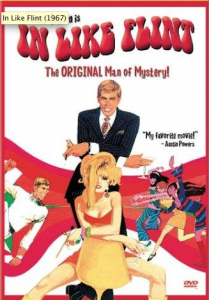 I’ve been obsessed with this score since dinosaurs ruled the earth. It’s funny — being able to trigger pretty much any sound from the guitar isn’t necessarily as liberating as you might think. Sure, when you first try it out, it’s thrilling to conjure an electric piano sound from the fretboard. But who wants to hear some schmo noodle aimlessly on electric piano when they could be noodling aimlessly on guitar?
For better or worse, I find myself using this technique repeatedly. When I double a part effectively, the result still seems like part of the guitar cosmos. It feels like expanding the palette, as opposed to vomiting on it. (Not that I’d be above vomiting on a palette if it helped create a cool painting.)
Did anyone else encounter this sort of childhood musical contamination? A melody, progression, or tone that infected you early on, and colored everything after? I’m not talking image, like falling in love with the Beatles on Ed Sullivan or Nickelback on the CBC because they were so frickin’ cool. I mean a primal sonic imprint. Anyone?
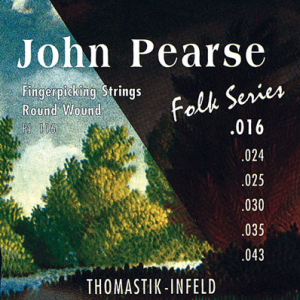 No longer ridiculously expensive. Now they’re just very expensive. I spent last week covering the Musikmesse musical instrument trade show in Frankfurt, Germany, for Premier Guitar. I had a blast, and Chris Kies and I posted details and pics of more than 70 new products. (Here’s the short list of our personal faves.) Kies shot lots of video, and will be posting more than 50 demo segments to the PG site in the coming weeks.
But Messe is hellishly loud, far noisier than NAMM. When I finally got home and picked up a guitar, it was an acoustic. I was trying something new, based on info I obtained from Mary Faith Rhoads-Lewis, CEO of Breezy Ridge, a company that distributes several brands for acoustic musicians, including John Pearse strings.
I’d previously geeked out here about about the strangest and most expensive guitar strings I’d ever tried: this “rope core” set from Austria’s Thomastik-Infeld. Reader/cool guy Al Milburn turned me on to them, and I wrote about them here. And I recently posted this video demonstrating how the transformed my old Martin 0-17 into a compelling steel/nylon hybrid with a unique and expressive voice.
Anyway, Ms. Rhoads-Lewis told me that the late John Pearse originally created this set for Thomastik, and that the John Pearse Folk Fingerpicking set [PJ116] is identical to what the Austrian company sells. Best part: You can get them in the States for under $20, as opposed to a walloping $35 for the Thomastiks. She also told me that their magic works in reverse: You can put this relatively low-tension set on a classical guitar for a very different sort of hybrid steel-string sound. (This, she said, is exactly what the great Brazilian player Bola Sete used to do.)
I popped a set on my old Yairi classical. The feel was — totally strange, and in precisely the opposite way as on the Martin. The tone was edgy and exciting, but the tension seemed a little too extreme. If just seemed a little too … high-strung, in every sense. Then I tried lowering the entire tuning a whole step, with the sixth dropped all the way to C.
And … oh, my. Check it out:
Summary: Holy cannoli, I love how this sounds. And there’s something psychologically satisfying about the transformation too. See, this guitar has always been a bit … tragic to me. I got it when I was 16. My classical guitar prof at UCLA said I needed a better instrument, and my every-supportive folks, bless ’em, helped me buy this Alvarez Yairi for around $700 (in 1970s dollars). It was a top-tier model for Alvarez, signed by luthier Kazuo Yairi, and boasting lovely Brazilian rosewood backs and sides. It was a huge upgrade for me, but as I got deeper into classical playing, its shortcomings emerged. Had I not shifted my studies to composition, I’d have needed to upgrade again. I envied the Igancio Fleta y Hijos models my two teachers played, but at around $3,000, they were beyond my budget, even with parental help. (Pity — their current value is approaching $50,000.) So I’ve used this instrument as a limited but decent-sounding model suitable for pop work, if not serious classical concertizing.
MORE→

Howdy from Frankfurt! I’m here for the week covering Musikmesse for Premier Guitar magazine. Messe is like NAMM, only somewhat larger and way louder. With beer and sausage. And probably lots of accordions, because you can’t have beer, sausage, or music trade shows without accordions.
You can check the many daily pics and notes posted at PG‘s Facebook page. We have a strict “new gear only” policy. No NAMM retreads — only items being introduced here in Frankfurt. Should be interesting!
:pacman: :pill: :beer: (pretend the pill is a sausage)
|
|


















